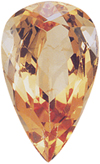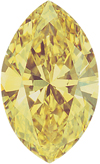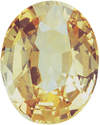OPTIMUM COLOR
As one of three primary colors,
yellow is an important color,
but it represents only a
minority of the basic hues
encountered in colored gemstones.
Starting with ruby and rhodolite
for red, there are sapphire
and aquamarine for blue,
and emerald and peridot for
green. In fact, the abundant
numbers and types of red,
blue, and green gemstones
account for nearly 90 percent
of all gemstones. Compared
to that, yellowish gemstones
are limited to Imperial topaz,
fancy yellow diamond, yellow
sapphire, and a few other
varieties. Yellow covers
a wide range, however, from
light yellow to nearly orange.
Each gem variety has its
optimum coloration, making
it important to select the
subtle color that brings
out the best of that gemstone.
That subtle color is closely
tied to the value of the
gemstone. |
 |
Weight :2.50
ct
Size (mm): L10.9 x W 6.7 x
D 4.92
Untreated
US $1,000 |
Imperial Topaz
Yellow material, usually classified
separately as yellow topaz,
is not as impressive as strongly
orange material. Being the
same mineral, they have the
same refractive index, hardness,
and specific gravity--- but
a hue and saturation that
bring out the greatest beauty
of the gemstone are important
elements of quality. Imperial
topaz must have some orange
coloration in order to fully
realize its potential beauty.
Additionally, high-quality
rough and an appropriate
cut will give a gemstone
a strong brilliance, resulting
in a beautiful stone like
the one pictured here. |
|
|
Fancy Yellow Diamond
The key to the beauty of a fancy
yellow diamond is a lemon-yellow
color. Material that is close to
a pure yellow color is the best.
Topaz, on the other hand, does
not occur in a vivid color like
the fancy yellow diamond shown
here. |
Weight
: 1.74 ct
Size (mm): L 11.0 x W 6.6 x D
4.19
Untreated
US $40,000 |
 |
 |
Weight
:1.54 ct
Size (mm): L 7.5 x W 5.9 x D
3.83
Untreated
US $300 |
Yellow
Sapphire
As with fancy yellow diamond, a lemon
color is the key to a beautiful yellow
sapphire. This is different from
Imperial topaz, which is preferred
in orange hues. Though both are gemstones
with a yellowish color, there are
subtle differences in their beauty
(as with anything created by nature).
Again, it is important to focus on
the featured of different gemstones
and to understand their optimum colors. |
|
 |
JUDGING QUALITY
The quality scale for Imperial topaz
spans a particularly wide range
of hues. Beauty grade S consists
of an ogrange color that is strongly
reddish, while lighter stones with
tone levels of 1 to 2 in beauty
grade A are basically yellow. Darker
tones (levels 3 to 4) of beauty
grade A fall in between, with an
orange-yellow color.
Quality levels 4-S and 4-A are the
most preferred hues for Imperial
topaz. The mosaic patterns seen in
these stones will display a good
balance of light and dark tones.
Topaz that is a very pale yellow
(tone level 2 and below) or a very
dark orange does not convey a deep
sense of beauty. |
|